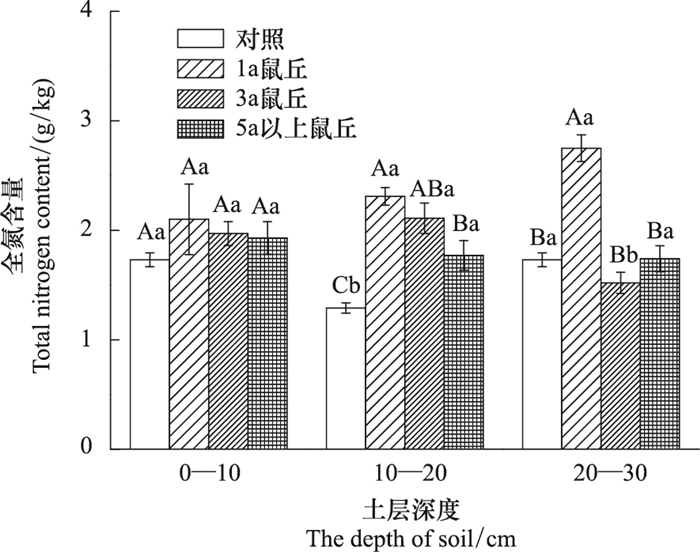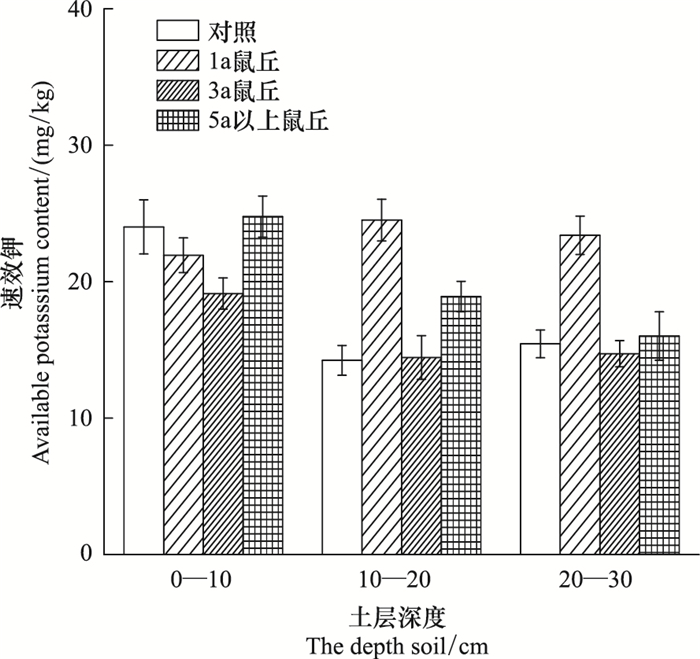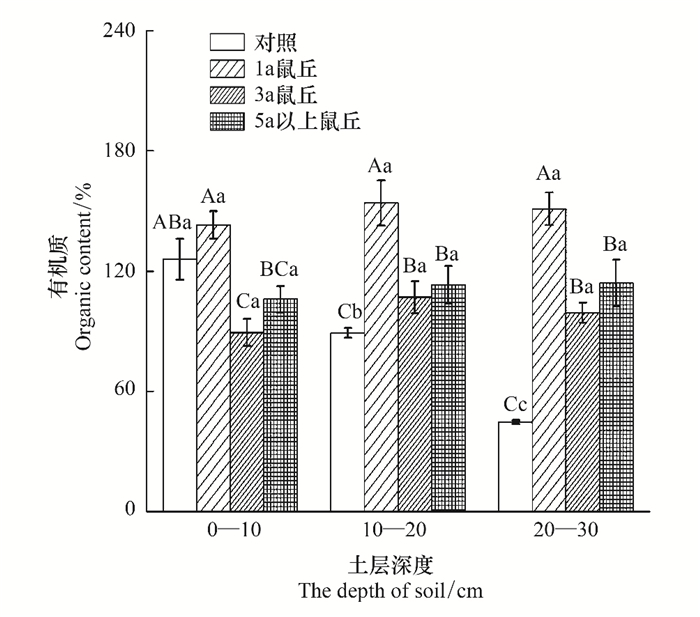文章信息
- 鲍根生, 王宏生, 曾辉, 卡着才让, 马志贵, 刘生财
- BAO Gensheng, WANG Hongsheng, ZENG Hui, KAI Zhuocairang, MA Zhigui, LIU Shengcai
- 不同形成时间高原鼢鼠鼠丘土壤养分分配规律
- The allocation pattern of soil nutrients in plateau zokor mounds of different ages
- 生态学报, 2016, 36(7): 1824-1831
- Acta Ecologica Sinica, 2016, 36(7): 1824-1831
- http://dx.doi.org/10.5846/stxb201409261907
-
文章历史
- 收稿日期: 2014-09-26
- 网络出版日期: 2015-08-05
2. 青海省河南县草原专业综合队, 河南县 811500
2. Grassland professional team of Henan Mongolia Autonomous County, HenanCounty 811500, China
青藏高原被誉为“世界第三极”,是我国最大的草地畜牧业生产基地和重要的生态屏障[1],其中,高寒草甸是青藏高原最主要的草地类型,约占整个高原面积的35%[2, 3, 4]。多年来,由于过度放牧、全球气候变暖、鼠类动物活动加剧和人类活动干扰等因素综合作用,导致高寒草甸退化面积不断扩大[5, 6]。其中,草地载畜量过高是造成草地退化的主要原因,大面积的退化草地便成为草原鼠类种群快速繁殖和扩展温床[7, 8, 9]。由于草原鼠类的数量不断增加,进一步加速高寒草地退化进度,最终造成极度退化景观“黑土滩”面积持续增加[5, 10, 11]。因此,草原鼠类种群数量增加不仅能从侧面反映草地退化的程度,而且成为加剧退化草地形成的重要因素[6]。
高原鼢鼠(Myospalax baileyi)是一种视力退化、营地下活动、以植物根系为食的小型哺乳动物。广泛分布在青藏高原退化草地中,一般密度为10—25只/hm2[2]。高原鼢鼠主要以3—20cm的植物根系为食物来源,其挖掘活动将地下新鲜土壤上翻到草地表面,形成大小不一的土丘[2, 12, 13],改变土壤形态、造成土壤垂直和水平结构发生变化,进而影响土壤中物质循环速率[14]。因此,高原鼢鼠的取食和挖掘行为对高寒草地生态系统产生显著影响,改变草地群落物种多样性[15]和土壤理化性质[16]。由于草地群落的原生植被严重破坏,裸露的鼠丘为杂草提供适宜生长的环境和空间,造成鼠丘植被组成和土壤养分重组和分配[2, 17, 18, 19]。家畜践踏和恶劣环境因素的共同作用,最终导致裸露的鼠丘变成植被盖度低且以毒杂草为优势种的“黑土滩”[20, 21]。目前,有关高原鼢鼠的研究主要集中在对高原低氧环境适应机制、高寒草地植被演替和生物防控等方面[22, 23, 24]。在高原低氧适应方面研究表明:高原鼢鼠通过增强肝脏中苹果酸天冬氨酸代谢途径来补充挖掘活动中的能量消耗[22]。张偃铭等人研究表明:由于高原鼢鼠主要以双子叶植物的根为食物来源,种群密度和草地产草量呈负相关,导致双子叶植物重要值降低,进而降低草地群落多样性[22]。高原鼢鼠的生物防控措施主要以植物源杀鼠剂、生物毒素和天敌控制为主,这些措施能有效控制高原鼢鼠的种群密度,同时对其他生物和生态环境是安全的[23]。
高原鼢鼠的造丘活动能对土壤结构和土壤养分产生影响,鼢鼠干扰对土壤理化性质研究多集中在干扰区和对照区的对比研究;但鼢鼠鼠丘植物群落随着时间推移会出现:杂类草入侵-单子叶和双子叶植物共存-单子叶为优势种的演替规律[25]。由于植物组成差异与土壤养分有很大的相关性,因此探索不同形成时间鼠丘土壤养分差异对鼠丘植物演替具有重要的生态学意义,但目前对不同形成时间鼠丘养分和垂直方向分布差异的研究报道尚少。基于此本试验以青藏高原高原鼢鼠核心分布区的不同年份鼠丘为研究对象,通过开展:(1)不同形成时间的高原鼢鼠鼠丘土壤养分变化规律;(2)鼢鼠鼠丘在不同土层土壤养分含量的变化规律;探讨高原鼢鼠鼠丘土壤养分再分配规律,为青藏高原地区退化草地生态恢复重建提供科学依据。
1 材料和方法 1.1 研究地区自然概况研究区域位于青海省黄南藏族自治州河南县赛尔龙乡尕欠村,地理位置为北纬34°35′18.46″,东经101°51′13.31″,海拔3568 m。该地区气候具有典型的高原大陆性气候特点,冷季漫长寒冷,暖季短暂,气候湿润多雨。年温差较小,年降水量597.1—615.5mm,多集中在6—10月。草地植物生长期较短,多为120—140d。
主要植被类型为高寒嵩草草甸。主要优势植物种为矮嵩草(Kobresia humilis)、线叶嵩草(Kobresia capillifolia),主要伴生种为垂穗披碱草(Elymus nuatans)、早熟禾(Poa pratensis)、芒溚草(Koeleria litvinowii)、鹅绒委陵菜(Potentilla anserina)、黄帚橐吾(Ligularia virgaurea)、多裂委陵菜(Potentilla multifida)、多枝黄芪(Astragalus polycladus)、茵陈蒿(Artemisia capillaris)、秦艽(Gentiana macrophylla)、湿生扁蕾(Gentianopsis paludosa)、细叶亚菊(Ajania tenuifolia)等。
1.2 研究方法 1.2.1 不同形成时间高原鼢鼠鼠丘类别划分2013年8月在高原鼢鼠危害严重的天然草地上,根据鼠丘形成的时间采样土壤样品。根据鼠丘上植被盖度差异,将鼠丘划分为:1年鼠丘(30—180 d内形成,植被盖度为6%—40%)、3年鼠丘(3—4a内形成,植被盖度达到70%以上)和5年以上鼠丘(植被盖度在85%以上)3种类型[26, 27, 28]。
1.2.2 样地设置2012年5月在高原鼢鼠危害严重地区的天然草场上选取200m×200m样区2个,两个试验区间隔200m。其中1个样区采用人工捕杀方法的清除该区域内的高原鼢鼠,同时为避免大型食草动物对鼠丘的践踏,用围栏将试验区围封。围封前每年11月到次年6月试验区进行自由放牧,每公顷约8只欧拉羊。同时,试验区土壤类型为典型的高寒草甸土。
1.2.3 土壤样品的采集和处理2013年8月分别在高原鼢鼠危害区选取3种类型的鼠丘各5个,用土钻分别采集0—10、10—20、20—30cm深度的土壤样品。同时在高原鼢鼠防除区,选择没有鼠丘分布的区域作为对照区,每隔5 m,采集不同深度的土壤样品,重复3次。将土壤样品装入密封的塑料袋内带回实验室,放置于阴凉处风干,过160目土壤筛,装入密封袋内用于测定土壤全氮、速效氮、全磷、速效磷、速效钾及有机质含量。
1.2.4 土壤理化性质分析各指标的测定参照鲍士旦的方法[29],测定土壤全氮(凯氏定氮法)、速效氮(碱解蒸馏法)、全磷(氢氧化钠熔融-钼锑抗比色法)、速效磷(钼锑抗比色法)、速效钾(火焰光度计光谱分析法)、土壤有机质(重铬酸钾法)。
1.3 数据分析采用双因素方差分析方法,分析不同类型鼠丘、不同深度的土壤养分变化以及二者的交互作用。数据分析时进行方差齐性检验,如方差齐性不齐,采用非参数检验Mann-Whitney U检验进行两两比较。数据采用SPSS19.0软件进行分析,所有数据均为平均值±标准误表示。
2 结果与分析鼢鼠鼠丘土壤养分随着鼠丘形成时间延长,各种类型鼠丘存在显著差异(表 1,P<0.01)。其中,土壤全氮和速效氮含量随着鼠丘形成时间增长呈降低的趋势,总体表现为:1年鼠丘>3年鼠丘>5年鼠丘>对照区(图 1—图 2);1年鼠丘土壤全氮含量随着土层深度增加而不断增加,而对照区随着土层深度增加呈先降低后上升的变化且土层间差异显著,多年鼠丘土壤全氮含量却随着土层深度增加而降低(图 1)。1年、5年形成鼠丘和对照区土壤速效氮含量随着土层深度增加呈先降低后增加的变化,而3年鼠丘10—20cm土层速效氮含量显著高于其他年份鼠丘(图 2)。土壤全磷含量在鼠丘表层随着鼠丘形成时间的延长呈显著增加趋势,表现为:5年鼠丘>3年鼠丘>1年鼠丘>对照区,且鼠丘土壤全磷含量显著高于对照;随着土层深度增加,1年、3年形成鼠丘和对照区土壤全磷含量随着形成时间延长呈先增加后下降的变化,而5年形成鼠丘却随着土层深度增加而不断降低(图 3)。土壤速效磷含量在鼠丘表层随着鼠丘形成时间的延长呈降低趋势,表现为:5年鼠丘>3年鼠丘>1年鼠丘,且5年鼠丘土壤速效磷含量显著低于其他年份鼠丘和对照区;随着土层深度增加土壤速效磷含量表现为:5年鼠丘>1年鼠丘>3年鼠丘>对照,且1年鼠丘和5年鼠丘速效磷含量显著高于3年鼠丘和对照区(图 4)。土壤速效钾含量随着鼠丘形成时间的延长,在不同土层呈现先下降后上升的变化趋势,总体表现为:1年鼠丘>5年鼠丘>3年鼠丘。对照区和5年鼠丘表层土壤速效钾含量显著高于3年鼠丘;而在10—20cm和20—30cm土层,1年鼠丘土壤中速效钾含量显著高于对照区、3年和5年鼠丘(图 5)。土壤有机质含量随着鼠丘形成时间的延长在各土层呈现先下降后上升的变化趋势,表现为:1年鼠丘>5年鼠丘>3年鼠丘。其中,第1年形成的鼠丘土壤有机质含量显著高于第3年和5年以上形成的鼠丘(图 6,P<0.05)。对照区土壤有机质含量随着土层深度增加不断降低,且各土层间差异显著(图 6),而不同年份鼠丘在各土层间土壤有机质含量差异不显著(图 6,P > 0.05)。

|
| 图 1 不同类型鼠丘土壤全氮在不同土层变化 Fig.1 Total nitrogen content of different types layer of mound in different soil layer |

|
| 图 2 不同类型鼠丘土壤速效氮在不同土层的变化 Fig.2 Available nitrogen content of different types of mound in different soil |

|
| 图 3 不同类型鼠丘土壤全磷在不同土层变化 Fig.3 Total phosphorus content of different types of mound in different soil layer |

|
| 图 4 不同类型鼠丘土壤速效磷在不同土层的变化 Fig.4 Available phosphorus content of different types of mound in different soil layer |

|
| 图 5 不同类型鼠丘土壤速效钾在不同土层变化 Fig.5 Available potassium content of different types of mound in different soil layer |

|
| 图 6 不同类型鼠丘土壤有机质在不同土层的变化 Fig.6 Organic content of different types of mound in different soil layer |
| 土壤养分 Soil nutrient | 方差来源 Source of variance | 自由度 df | F | P |
| 全氮 | 鼠丘类型 | 3 | 17.99 | <0.01 |
| Total nitrogen | 土壤深度 | 2 | 0.283 | 0.76 |
| 鼠丘类型×土壤深度 | 6 | 4.77 | <0.01 | |
| 速效氮 | 鼠丘类型 | 3 | 81.97 | <0.01 |
| Available nitrogen | 土壤深度 | 2 | 6.60 | <0.01 |
| 鼠丘类型×土壤深度 | 6 | 15.27 | <0.01 | |
| 全磷 | 鼠丘类型 | 3 | 311.64 | <0.01 |
| Total phosphorus | 土壤深度 | 2 | 397.59 | <0.01 |
| 鼠丘类型×土壤深度 | 6 | 867.54 | <0.01 | |
| 速效磷 | 鼠丘类型 | 3 | 100.74 | <0.01 |
| Available phosphorus | 土壤深度 | 2 | 46.63 | <0.01 |
| 鼠丘类型×土壤深度 | 6 | 37.50 | <0.01 | |
| 速效钾 | 鼠丘类型 | 3 | 14.51 | <0.01 |
| Available potassium | 土壤深度 | 2 | 15.56 | <0.01 |
| 鼠丘类型×土壤深度 | 6 | 4.49 | <0.01 | |
| 有机质 | 鼠丘类型 | 3 | 35.58 | <0.01 |
| Organic matter | 土壤深度 | 2 | 4.04 | 0.03 |
| 鼠丘类型×土壤深度 | 6 | 8.21 | <0.01 |
高原鼢鼠作为青藏高原地区唯一地下活动的啮齿动物,跟美洲的囊鼠(Thomomy stalpoides)、南美洲的鼢足鼠(Myospalax baileyi)等啮齿动物一样为扩展和维护地下活动洞道系统,不断将地下土壤上翻到表层[30, 31]。据估计1只高原鼢鼠每年将1t左右的土壤从地下运输到地表[32]。鼢鼠造丘活动将表层土壤和地下深层土壤混匀,改变土壤的团粒结构。Mimlke研究表明:囊鼠鼠丘土壤团粒结构接近砂壤土,这与未出现鼠丘地域的壤土有很大差异;与壤土相比,砂壤土具有较大的田间持水量和土壤萎蔫系数,能为土壤种子库中种子的萌发提供了充足的水分[33]。另外,高原鼢鼠造丘活动会影响鼠丘上的物种组成及微生物群落,这与周围未干扰区域有一定差异,造成差异的原因可能与土壤紧实度、湿度和养分等因素有关[19, 31]。本实验研究表明:不同形成时间鼠丘的土壤养分与周围未干扰区域的土壤养分存在明显差异,其中1a鼠丘土壤中全磷、速效磷、全氮、速效氮和有机质含量显著高于未干扰区,这与张堰铭等人在海北定位站高原鼢鼠干扰区和未干扰区土壤养分调查结果一致[19]。这种差异可能是由于高原鼢鼠在挖掘搬运、回填、堆砌土丘以及后来由于物理力量的土壤移动的净效应产生了土壤垂直方向的混合和水平方向上的土壤成分异质性、排泄物的产生和土壤养分垂直分布有关[34]。一般情况下,土壤中氮和磷的含量随着土壤深度增加而迅速降低[35],而高原鼢鼠取食和挖掘过程中将底层养分含量较低的土壤上翻到地表[36, 37]。地下新鲜土壤在阳光照射作用下土壤温度不断增加,同时土壤的通气性增强,加速土壤中磷和氮的矿质化过程和转化效率,同时土壤微生物种类和数量也有所增加[38, 39]。随着形成时间的推移,多年的鼠丘土壤中的氮和磷的含量会持续降低[19],这种现象在研究中进一步得到证实。然而,在美国加州和犹他州地区的研究表明:鼠丘土壤中的氮、磷等营养成分含量明显低于周围未破坏的草地[17, 40],这可能与鼠类挖掘土壤的深度和土壤表层的风化强度有关,由于现阶段的实验尚未对表层土壤的风化强度进行研究,这些试验将在以后开展来进一步揭示鼠丘土壤和周边土壤差异的原因。
土壤有机质水平主要反映植物通过光合作用获取的碳和土壤经矿化途径消耗的有机质之间的平衡情况,它不仅是影响土壤酶活性和土壤微生物活动的重要影响因子,而且在改善土壤团粒化结构和提高鼠丘植被盖度等方面起到了积极作用[41]。许多研究表明:鼠类的造丘活动能有效改善土壤的紧实度,进而形成比较疏松的土壤。疏松的土壤形成较大的土壤间隙,能为根际氧化代谢提供良好环境,同时也能为土壤种子库中的种子创造适宜的发芽条件,加快幼苗在鼠丘的定植[42]。另外,植被恢复过程中会增加土壤中微生物数量和活性[42, 43]。植物根系虽然位于地下黑暗环境中,但呼吸作用是必需的,这就要求植物根系与外界环境保持良好的通透性。同时,疏松的土壤也能为幼苗根系的定植和扩展提供有利环境。土壤中大量有机质能够促进土壤中阳离子交换和矿物质的形成。Mimlke研究表明:美洲囊鼠鼠丘土壤中磷和钾含量比未出现鼠丘地域分别增加20.7%和72.7%,尤其在高寒草甸的土壤类型主要以黑钙土为主,鼠丘土壤中磷、钾和镁等元素含量比周边地域分别高41%、120%和17%[33]。Abaturov研究表明:鼠类的挖掘活动同时能影响矿物质的形成和利用过程。鼠类能将深层土壤中丰富的矿物质通过挖掘活动运输到地表。在美国明尼苏达州研究结果表明:土壤缺钙条件下,囊鼠鼠丘土壤中钙含量比没有鼠丘地域要高,能有效缓解土壤缺钙的现状[44]。从图 5中可以看出,鼠丘土壤中有机质含量明显高于对照区,造成鼠丘土壤有机质含量提高的主要原因可能是:(1)鼢鼠挖掘及运输地下土壤时,底层土壤中大量植物枯死根系成为有机质的主要来源;(2)上翻的土壤将原来地表植物掩埋,由于缺乏光照和氧气地上部分逐渐腐烂,成为主要的有机质来源的另一途径。在青藏高原地区草地土壤中钾含量比较高,土壤基本表现为富钾和镁[45],同时鼠丘上植被被破坏,导致土壤中钾易释放和淋失,导致含钾量降低。但随着土层深度增加速效钾含量在不同类型的鼠丘土壤中含量有差异(图 5),原因可能是由于高原鼢鼠粪便经成丘活动被运送到表层,而粪便中含有大量的速效钾,导致1年鼠丘速效钾含量较高,而多年鼠丘由于土壤结构趋于稳定,故速效钾含量降低[46]。
综上所述,本研究从鼢鼠造丘后形成大面积的鼠丘为出发点,探讨鼠丘土壤养分在时间和空间变化的规律。研究结果不仅为鼢鼠造丘活动能有效改变土壤理化性质提供可靠的数据资料,同时能从侧面解释土壤在短时间形成养分富集的肥力岛的原因,为土壤种子库中种子创造良好的萌发和生长环境,加快草地物种多样性提高和草地群落稳定性,因此,高原鼢鼠被誉为“草地生态系统的工程师”[19]。这与传统的高原鼢鼠的挖掘活动会加速草地退化和需采取手段进行防治的理论相悖。但草地退化的主要因素是草地载畜量过高,而放牧强度与高原鼢鼠的种群密度正相关,在适当的放牧强度下,高原鼢鼠对草地生产力和草地群落的稳定性影响较低,只有放牧强度过高时其挖掘活动才会加速草地退化[47]。因此,高原鼢鼠对草地生态系统的贡献是不容忽视的,针对青藏高原地区退化草地的治理需综合考虑各方面因素的影响,提出可持续发展的治理措施。
| [1] | Hu Y G, Chang X F, Lin X W, Wang Y F, Wang S P, Duan J C, Zhang Z H, Yang X X, Luo C Y, Xu G P. Effects of warming and grazing on N2O fluxes in an alpine meadow ecosystem on the Tibetan plateau. Soil Biology and Biochemistry, 2010, 42(6): 944-952. |
| [2] | Zhang Y M, Liu J K. Effects of plateau zokors (Myospalax fontanierii) on plant community and soil in an alpine meadow. Journal of Mammalogy, 2003, 84(2): 644-651. |
| [3] | Cao G M, Xu X L, Long R J, Wang Q L, Wang C T, Du Y G, Zhao X Q. Methane emissions by alpine plant communities in the Qinghai-Tibet Plateau. Biology Letters, 2008, 4(6): 681-684. |
| [4] | Zheng Y, Yang W, Sun X, Wang S P, Rui Y C, Luo C Y, Guo L D. Methanotrophic community structure and activity under warming and grazing of alpine meadow on the Tibetan Plateau. Applied Microbiology and Biotechnology, 2012, 93(5): 2193-2203. |
| [5] | 周华坤, 赵新全, 周立, 刘伟, 李英年, 唐艳鸿. 青藏高原高寒草甸的植被退化与土壤退化特征研究. 草业学报, 2005, 14(3): 31-40. |
| [6] | Harris R B. Rangeland degradation on the Qinghai-Tibetan plateau: a review of the evidence of its magnitude and causes. Journal of Arid Environments, 2010, 74(1): 1-12. |
| [7] | 施银柱. 草场植被影响高原鼠兔密度的探讨. 兽类学报, 1983, 3(2): 181-187. |
| [8] | 边疆晖, 樊乃昌, 景增春, 施银柱. 高寒草甸地区小哺乳动物群落与植物群落演替关系的研究. 兽类学报, 1994, 14(3): 209-216. |
| [9] | Richens V B. An evaluation of control on the Wasatch pocket gopher. The Journal of Wildlife Management, 1965, 29(3): 413-425. |
| [10] | 周华坤, 周立, 赵新全, 刘伟, 严作良, 师燕. 江河源区 "黑土滩" 型退化草场的形成过程与综合治理. 生态学杂志, 2003, 22(5): 51-55. |
| [11] | 尚占环, 龙瑞军. 青藏高原"黑土型"退化草地成因与恢复. 生态学杂志, 2005, 24(6): 652-656. |
| [12] | Gettinger R D. Energy and water metabolism of free-ranging pocket gophers, Thomomys bottae. Ecology, 1984, 65(3): 740-751. |
| [13] | Reichman O, Smith S C. Impact of pocket gopher burrows on overlying vegetation. Journal of Mammalogy, 1985, 66(4): 720-725. |
| [14] | Reichman O J, Seabloom E W. The role of pocket gophers as subterranean ecosystem engineers. Trends in Ecology & Evolution, 2002, 17(1): 44-49. |
| [15] | Yoshihara Y, Okuro T, Buuveibaatar B, Undarmaa J, Takeuchi K. Responses of vegetation to soil disturbance by Sibelian marmots within a landscape and between landscape positions in Hustai National Park, Mongolia. Grassland Science, 2010, 56(1): 42-50. |
| [16] | Wilkinson M T, Richards P J, Humphreys G S. Breaking ground: pedological, geological, and ecological implications of soil bioturbation. Earth-Science Reviews, 2009, 97(1/4): 257-272. |
| [17] | McDonough W T. Revegetation of gopher mounds on aspen range in Utah. Western North American Naturalist, 1974, 34(4): 267-275. |
| [18] | Hobbs R J, Gulmon S L, Hobbs V J, Mooney H A. Effects of fertiliser addition and subsequent gopher disturbance on a serpentine annual grassland community. Oecologia, 1988, 75(2): 291-295. |
| [19] | Zhang Y M, Zhang Z B, Liu J K. Burrowing rodents as ecosystem engineers: the ecology and management of plateau zokors Myospalax fontanierii in alpine meadow ecosystems on the Tibetan Plateau. Mammal Review, 2003, 33(3/4): 284-294. |
| [20] | 韩立辉, 尚占环, 任国华, 王彦龙, 马玉寿, 李希来, 龙瑞军. 青藏高原"黑土滩"退化草地植物和土壤对秃斑面积变化的响应. 草业学报, 2011, 20(1): 1-6. |
| [21] | Liu W, Wang Q J, Wang X, Zhou L, Li F J, Li Y F. Ecological process of forming "BlacK-Soil-type" degraded grassland. Acta Agrestia Sinica, 1999, 7(4): 300-307. |
| [22] | Zhu R J, Rao X F, Wei D B, Wang D W, Wei L, Sun S Z. Functional difference of malate-aspartate shuttle system in liver between plateau zokor(Myospalax baileyi) and plateau pika(Ochotona curzoniae). Acta Physiologica Sinica, 2012, 64(2): 177-186. |
| [23] | 张堰铭. 高原鼢鼠对高寒草甸群落特征及演替的影响. 动物学研究, 1999, 20(6): 435-440. |
| [24] | 李娜娜, 黄彬, 张灵菲, 卫万荣, 张燕堃, 张卫国. 草地生态系统有害啮齿动物的生物防治. 草业科学, 2013, 30(5): 783-787. |
| [25] | 杨莹博, 辛小娟, 艾得协措, 杨雪, 王绍美, 储诚进, 任正炜, 王刚. 鼢鼠土丘植被恢复演替过程中的物种多样性变化. 草业学报, 2010, 19(1): 14-20. |
| [26] | 何俊龄, 张金沙, 杨莹博, 邓汉刚, 魏进招, 张卫国. 高原鼢鼠土丘空间格局及主要特征研究. 草业学报, 2006, 15(1): 107-112. |
| [27] | 韩天虎, 张卫国,丁连生. 高原鼢鼠栖息地的植被特征. 草业学报, 1999, 8(2): 43-49. |
| [28] | 江小雷, 张卫国, 杨振宇, 杜国祯. 不同演替阶段鼢鼠土丘群落植物多样性变化研究. 应用生态学报, 2004, 15(5): 814-818. |
| [29] | 鲍士旦. 土壤农化学分析. 北京: 中国农业出版社, 2005. |
| [30] | Contreras L C, Gutiérrez J R. Effects of the subterranean herbivorous rodent Spalacopus cyanus on herbaceous vegetation in arid coastal Chile. Oecologia, 1991, 87(1): 106-109. |
| [31] | Sherrod S K, Seastedt T R. Effects of the northern pocket gopher(Thomomys talpoides) on alpine soil characteristics, Niwot Ridge, CO. Biogeochemistry, 2001, 55(2): 195-218. |
| [32] | 王权业, 樊乃昌. 高原鼢鼠(Myospalax baileyi)的挖掘活动及其种群数量统计方法的探讨. 兽类学报, 1987, 7(4): 283-290. |
| [33] | Mielke H W. Mound building by pocket gophers(Geomyidae): their impact on soils and vegetation in North America. Journal of Biogeography, 1977, 4(2): 171-180. |
| [34] | Whicker A D, Detling J K. Ecological consequences of prairie dog disturbances. BioScience, 1988, 38(11): 778-785. |
| [35] | Rui Y C, Wang S P, Xu Z H, Wang Y F, Chen C R, Zhou X Q, Kang X M, Lu S B, Hu Y G, Lin Q Y. Warming and grazing affect soil labile carbon and nitrogen pools differently in an alpine meadow of the Qinghai-Tibet Plateau in China. Journal of Soils and Sediments, 2011, 11(6): 903-914. |
| [36] | Wang Q Y, Bian J H, Shi Y Z. Influence of plateau zokor mounds on the vegetation and soil nutrients in an alpine meadow. Acta Theriologica Sinica, 1993, 13(1): 31-37. |
| [37] | Wei X H, Li S, Yang P, Cheng H S. Soil erosion and vegetation succession in alpine Kobresia steppe meadow caused by plateau pika-a case study of Nagqu County, Tibet. Chinese Geographical Science, 2007, 17(1): 75-81. |
| [38] | Li J, Yang T, Zhu G. Studies on soil microbiology and decomposition of alpine meadow at Haibei Station//Proceedings of the International Symp of Alpine Meadow Ecosystem. Beijing: Science Press, 1989. |
| [39] | Laundre J W. Effects of small mammal burrows on water infiltration in a cool desert environment. Oecologia, 1993, 94(1): 43-48. |
| [40] | Koide R T, Huenneke L F, Mooney H A. Gopher mound soil reduces growth and affects ion uptake of two annual grassland species. Oecologia, 1987, 72(2): 284-290. |
| [41] | Li X G, Zhang M L, Li Z T, Shi X M, Ma Q, Long R J. Dynamics of soil properties and organic carbon pool in topsoil of zokor-made mounds at an alpine site of the Qinghai-Tibetan Plateau. Biology and Fertility of Soils, 2009, 45(8): 865-872. |
| [42] | Nystuen K O, Evju M, Rusch G M, Graae B J, Eide N E. Rodent population dynamics affect seedling recruitment in alpine habitats. Journal of Vegetation Science, 2014, 25(4): 1004-1014. |
| [43] | Baldrian P, Trögl J, Frouz J, Šnajdr J, Valášková V, Merhautová V, Cajthaml T, Herinková J. Enzyme activities and microbial biomass in topsoil layer during spontaneous succession in spoil heaps after brown coal mining. Soil Biology and Biochemistry, 2008, 40(9): 2107-2115. |
| [44] | Abaturov B D. The role of burrowing animals in the transport of mineral substances in the soil. Pedobiologia, 1972, 12(4): 261-266. |
| [45] | 辛国省, 龙瑞军, 尚占环, 丁路明, 郭旭生. 青藏高原东北缘放牧草地土壤矿物元素含量及分布特征. 草业学报, 2012, 21(2): 8-17. |
| [46] | 陈淑燕, 张德罡. 不同退化阶段高寒草甸草地土壤钾素的变化分析. 草原与草坪, 2013, 33(3): 74-77. |
| [47] | Zhang Y M, Zhou W, Fan N, Zhang D. Population dynamics and prediction of the plateau zokors.//Liu J, Wang Z, eds. Alpine Meadow Ecosystem Fascicle 3. Beijing: Science Press, 1991: 175-179. |
 2016, Vol. 36
2016, Vol. 36




